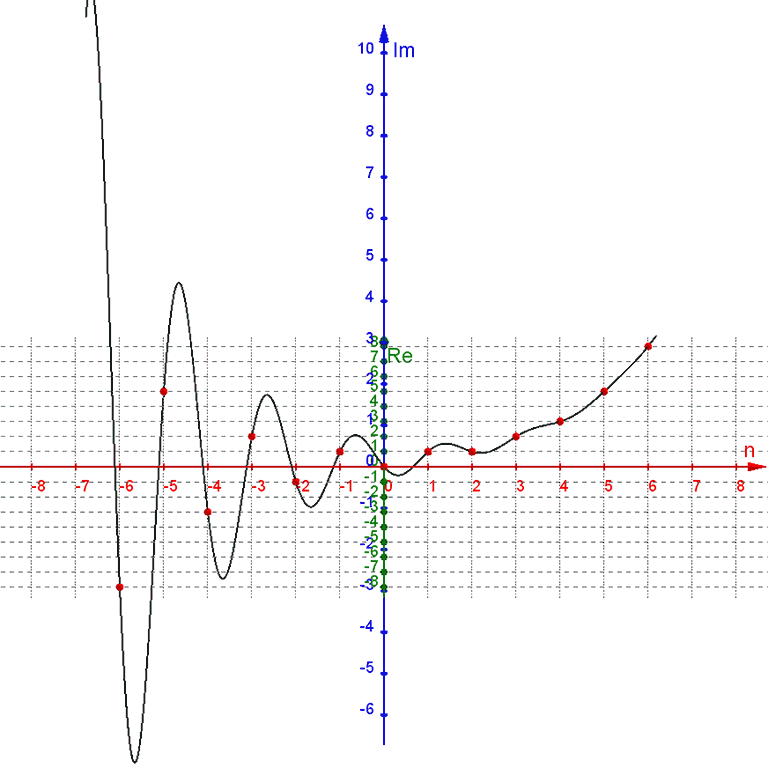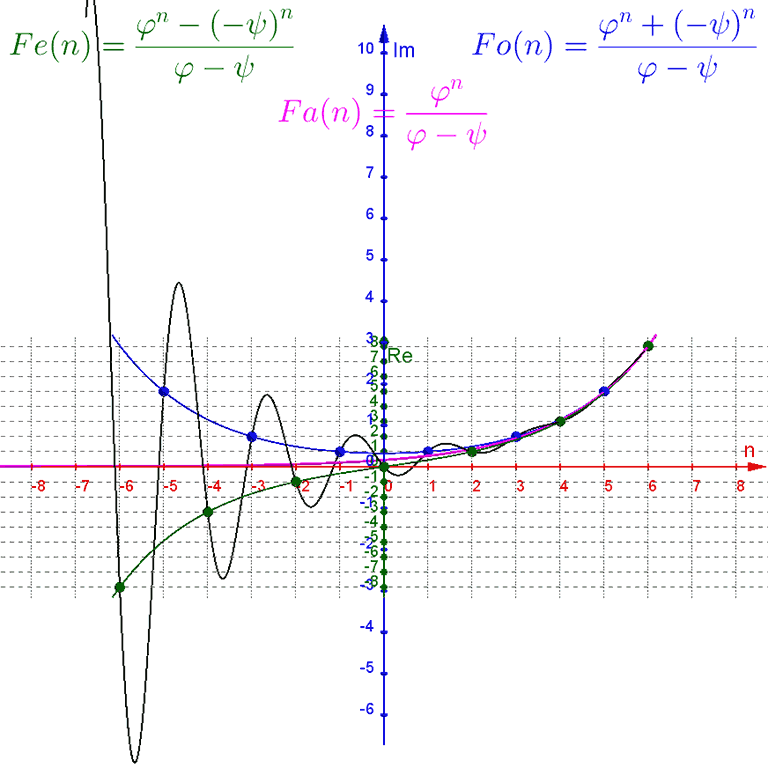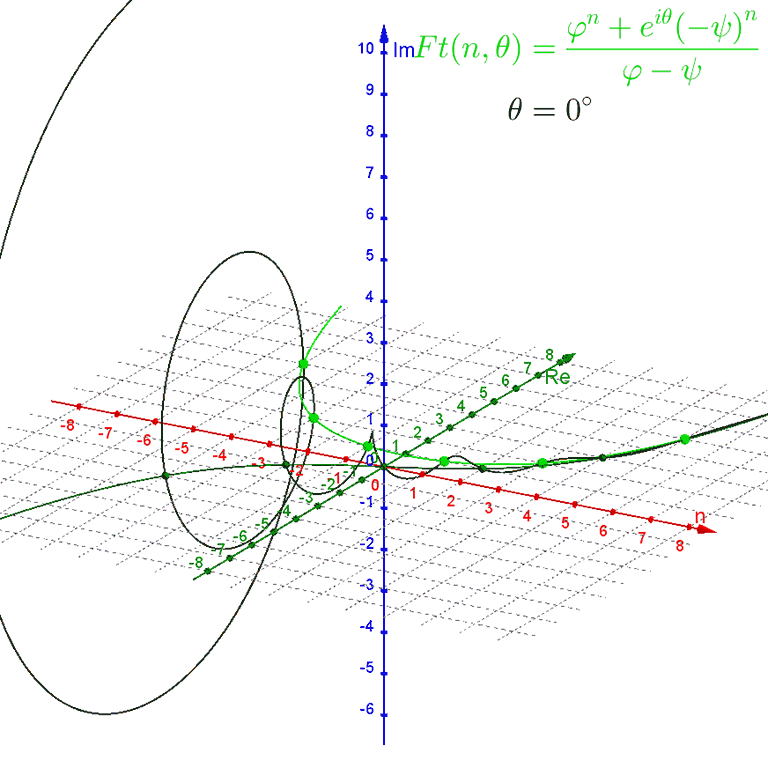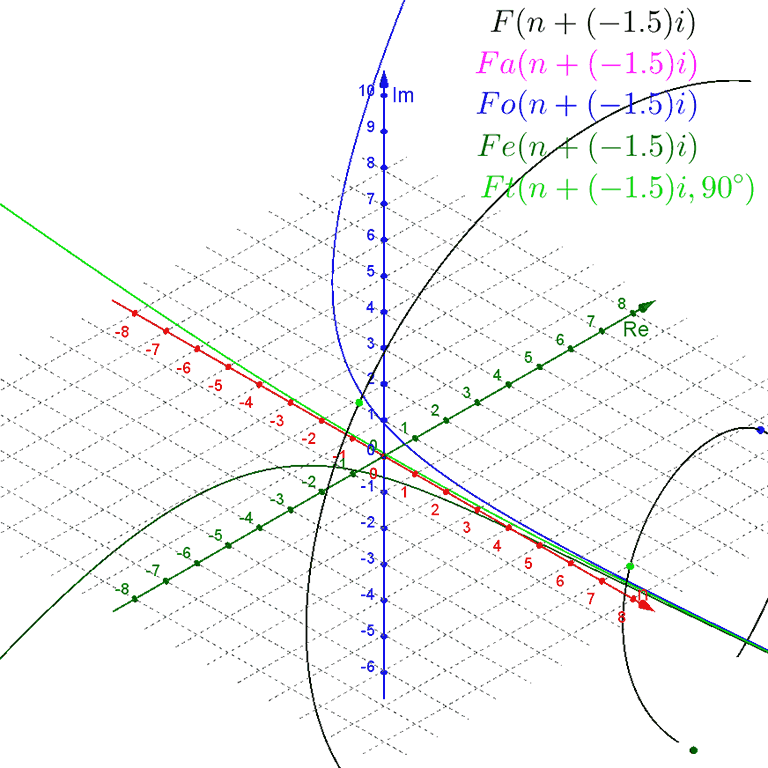I am investigating non-integer, complex-valued extensions of the Fibonacci sequence.
Problem
How do I modify the function
$$Ft(n, θ) = \frac{ϕ^{n + m i} + e^{i θ} (−ψ)^{n + m i}} {ϕ − ψ}$$
so it stays in contact with the spiral of the function
$$F(n) = \frac{ϕ^{n + m i} − ψ^{n + m i}} {ϕ − ψ}$$
as we vary the value of the constant $m$?
Background
The Fibonacci sequence $\{0, 1, 1, 2, 3, 5, 8, \,…\}$ is initially defined as a positive integer sequence with the relation $F_n = F_{n − 1} + F_{n − 2}$ and the starting values $F_0 = 0$ and $F_1 = 1$. It can be extended to negative values easily enough with the relation $F_n = F_{n + 2} – F_{n + 1}$. But calculating $F_n$ for an arbitrary value of $n$ with these relations requires calculating every value between the starting values and the desired value, which becomes tedious as $n$ gets large.
Luckily, there is a better way: Binet's formula $F(n) = \frac{ϕ^n − ψ^n} {ϕ − ψ}$, using the golden ratio $ϕ = \frac{1 + \sqrt{5}} {2} ≈ 1.618$ and its conjugate $ψ = \frac{1 − \sqrt{5}} {2} ≈ −0.618$. This function gives the $n$th Fibonacci number directly, without needing to calculate any intervening values.
Notice that Binet's formula does not require whole-number inputs for the value of $n$. However, because $ψ$ is a negative number being raised to the power of $n$, non-integer values of $n$ produce complex outputs. We can plot this in a $3\text{D}$ graph, with a one-dimensional real input $n$ on the $x$-axis, the real part of the two-dimensional complex output $F(n)$ on the $y$-axis, and the imaginary part of the complex output on the $z$-axis.
For negative values of $n$, the $ψ^n$-term dominates as a wide spiral around the $n$-axis that contracts towards the value of $ϕ^n$ as $n$ increases towards zero.
For positive values of $n$, the $ϕ^n$-term dominates, with the $ψ^n$-term contributing only a tiny wobble.
The spiral crosses the $n\text{Re}$ ($xy$) plane at every integer value of $n$.
Binet's formula also has some noteworthy variations:
- $Fa(n) = \text{round}\left(\frac{ϕ^n} {ϕ − ψ}\right)$ gives all Fibonacci numbers for positive integer values of $n$
- $Fe(n) = \frac{ϕ^n − (−ψ)^n} {ϕ − ψ}$ gives even-index Fibonacci numbers for even integer values of $n$
- $Fo(n) = \frac{ϕ^n + (−ψ)^n} {ϕ − ψ}$ gives odd-index Fibonacci numbers for odd integer values of $n$
Plotting these functions alongside the main function, we can see that $Fa(n)$ is a standard exponential curve in the center of the spiral of Binet's formula, while $Fe(n)$ is a sigmoid curve along the lower-real side of the spiral that touches it at every even-integer $n$, and $Fo(n)$ is a U-shaped curve along the upper-real side of the spiral that touches it at every odd-integer $n$.
Upon seeing this I wondered if there was a way to modify the pattern of $Fe(n)$ and $Fo(n)$ to get curves that touched the spiral at other points, and it turns out there is.
The function
$$Ft(n, θ) = \frac{ϕ^n + e^{i θ} (−ψ)^n} {ϕ − ψ}$$
rotates around the spiral of Binet's formula by the angle $θ$, starting out equivalent to $Fo(n)$ when $θ = 0°$ and becoming equivalent to $Fe(n)$ when $θ = 180°$.
So far so good. What happens if we allow complex values of $n$? Unfortunately, properly displaying a $2\text{D}$ input and a $2\text{D}$ output would require a $4\text{D}$ plot, which humans aren't well equipped to comprehend.
Instead, we can modify our 3D plot of Binet's formula and variations with a constant imaginary offset $m$, giving us for example $F(n + m i)$.
For $m = 0$ we get the original purely-real-input setup. For positive values of $m$ the spiral contracts around the exponential curve of $Fa(n + m i)$, which rotates up around the $x$-axis. For negative values of $m$ the spiral expands away from the exponential curve of $Fa(n + m i)$, which rotates down around the $x$-axis. However, while the plots of $Fe(n + m i)$, $Fo(n + m i)$, and $Ft(n + m i, θ)$ rotate with the exponential curve of $Fa(n + m i)$, they do not expand and contract with the spiral.
I have been unable to figure out how to modify them to match the expanding/contracting behavior.
Does anyone know how to change the function
$$Ft(n, θ) = \frac{ϕ^{n + m i} + e^{i θ} (−ψ)^{n + m i}} {ϕ − ψ}$$
so it stays in contact with the spiral of the function
$$F(n) = \frac{ϕ^{n + m i} − ψ^{n + m i}} {ϕ − ψ}$$
as we vary the value of the constant $m$?




Best Answer
In the context of extending the Fibonacci sequence to non-integer index value the natural formula is $$ F(n+m\,i) = \frac{\phi^{n + m\,i} − \psi^{n + m\,i}} {\phi − \psi}. $$ Since $\,\psi=-1/\phi<0,\,$ there is no problem with $\,\psi^n\,$ but what about $\,\psi^{m\,i}?\,$ Use the definition of the power function as in DLMF to get $$ \psi^{m\,i} = (-1)^{m\,i}(-\psi)^{m\,i} = (e^{-\pi})^m \phi^{-m\,i}.$$ Thus, a suitable formula is $$ F(n+m\,i) = \frac{\phi^{n + m\,i} −\ \psi^n (e^{-\pi})^m \phi^{-m\,i}} {\phi − \psi} $$ or some simple variation as needed.